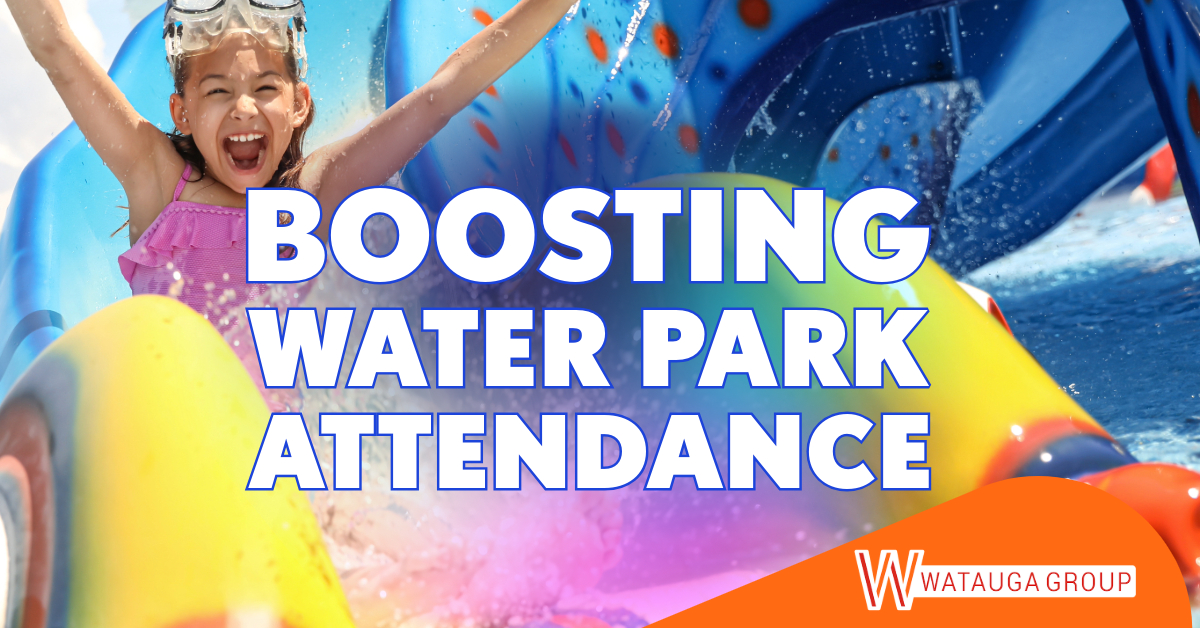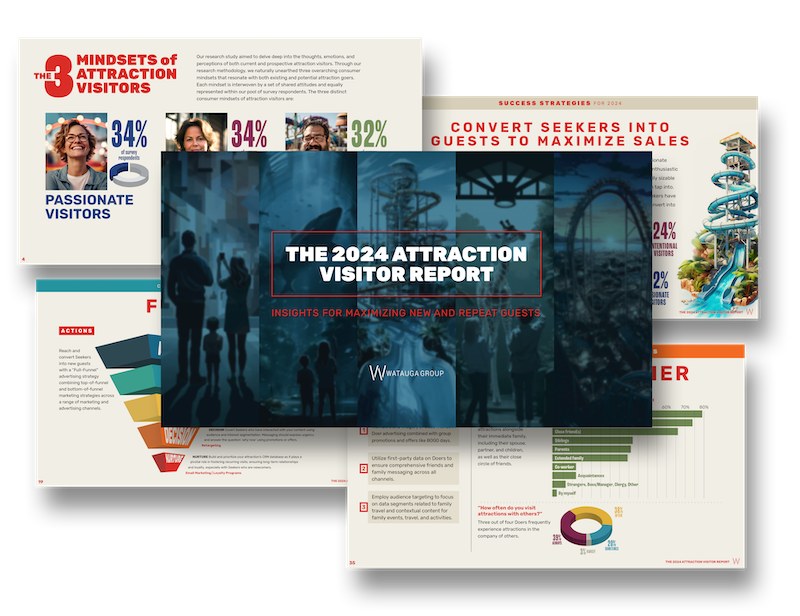 Water parks have long been a favorite summer destination, offering a refreshing escape from the heat and a day of fun for people of all ages. However, findings in Watauga’s 2024 Attraction Visitor Report, which surveyed the attitudes and motivations of 3,600 current and prospective attraction guests, revealed that children significantly influence the decision to visit water parks. This insight is crucial for understanding the dynamics of water park attendance and highlights the importance of a dual-targeting strategy that caters to both children and their parents. By effectively reaching both audiences through tailored marketing efforts, water parks can maximize their appeal and drive higher visitation.
Water parks have long been a favorite summer destination, offering a refreshing escape from the heat and a day of fun for people of all ages. However, findings in Watauga’s 2024 Attraction Visitor Report, which surveyed the attitudes and motivations of 3,600 current and prospective attraction guests, revealed that children significantly influence the decision to visit water parks. This insight is crucial for understanding the dynamics of water park attendance and highlights the importance of a dual-targeting strategy that caters to both children and their parents. By effectively reaching both audiences through tailored marketing efforts, water parks can maximize their appeal and drive higher visitation.
To help water park marketers capitalize on this insight this article will explore the following:
- How water parks can implement a multifaceted marketing approach that includes innovative push-pull strategies to engage kids and parents alike.
- How the use of market analysis and geotargeting can pinpoint the best times and places to reach your target audience, ensuring that every dollar spent delivers maximum ROI.
- How crafting messaging that directly speaks to the primary benefits for a family audience – such as entertainment and bonding – can elevate the appeal of your water park.
- How conducting a flighting analysis can optimize the timing and intensity of advertising campaigns, maximizing the impact of water park marketing efforts during peak seasons.
Kid Catalysts: Powering Family Fun
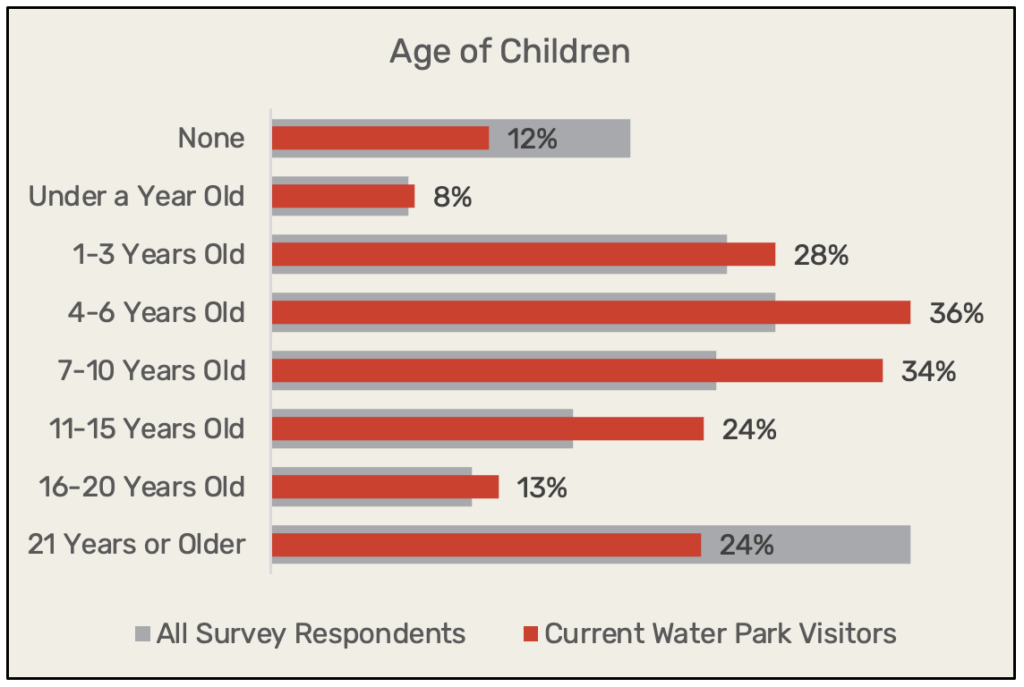
This chart illustrates the age distribution of all survey respondents compared to current water park visitors. Data indicates a higher proportion of younger children (ages 4-10) among current water park visitors, with 36% in the 4-6 age range and 34% in the 7-10 age range. Notably, current water park visitors are more likely to have children in the 4-15 age range, highlighting the importance of targeting families with younger children in water park marketing efforts.
Families with children are a dominant segment of water park visitors, particularly those with children between the ages of 4 and 15 years old. A striking 84% of current water park attendees prefer to visit attractions, including water parks, with their kids.
This statistic underscores the critical role that children play in the decision-making process for family outings. In essence, children are not just passive participants in water park visits; they are central to the experience. Their excitement and enthusiasm for water play drive their parents’ decision to visit, making them key players in the ongoing popularity and success of water parks.
With today’s capabilities, targeting households with kids can be a relatively easy demographic to reach. The key is to execute a delicate push-pull strategy that focuses on both kids and their parents, where the kids will become your brand advocates and the parents are the ultimate decision-makers and financiers. Individually, each target audience can be engaged through the media channels they prefer. For instance, kids can be reached through relevant content such as video ads on YouTube Kids or in children’s television programming. Reaching parents, on the other hand, should be data-driven, focused more on their behaviors and interests overlayed with syndicated research for channel selection.
In Watauga’s experience, many water parks are regionalized, specifically drive destinations where their core visitation stems from their home market or surrounding DMAs. Water parks should invest in their local communities through family-centric media – such as youth sports sponsorships or community events – to demonstrate their commitment to supporting families, associate their brand with family-friendly values, and amplify co-viewership between kids and parents that will foster goodwill and loyalty through an enhanced community presence.
The Family-Friendly Appeal
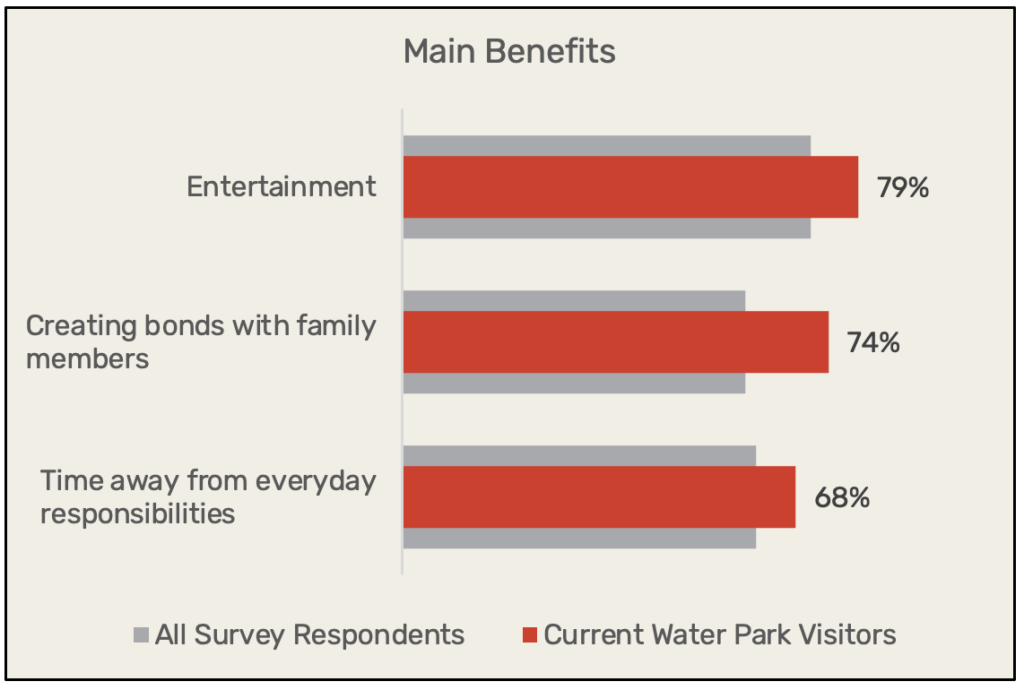
This chart compares the motivations for attractions between all survey respondents and current water park visitors. The top three motivations are entertainment, creating bonds with family members, and time away from everyday responsibilities. This data underscores the value of promoting water parks as venues for family bonding and entertainment
When asked what makes them want to visit an attraction, like a water park, 74% of current visitors listed the family-friendly nature of the attraction. For many families, the primary benefit of visiting attractions like water parks is the opportunity to create lasting memories and strengthen family bonds. Parents value experiences that bring their family closer, and water parks provide an ideal setting for this. The shared thrills of water slides, lazy rivers, and wave pools create moments of joy and escape from their daily life that families cherish. For more insights on the importance of escapism, check out Watauga’s recent blog post, Harnessing Escapism in Attraction Marketing.
Based on these findings, when building an asset library for marketing and promotional materials, water parks should frequently highlight family-friendly features and activities. Using vibrant, high-quality images and videos that showcase happy children and parents enjoying their time together is crucial. This includes capturing a variety of experiences such as:
Attractions:
Exciting water slides, relaxing lazy rivers, energetic wave pools, and/or interactive play areas
Amenities and Services:
Comfortable lounging areas, family cabanas, and/or kid-friendly dining
Special Events:
Themed nights, character meet-and-greets, and/or sensory-friendly days
Maximizing Family Visitation in Summer

Water parks inherently appeal to families due to their seasonal nature. Warm weather, combined with school vacations, attracts nearly 2 out of 3 water park guests who prefer to visit during favorable conditions, making water parks a prime destination during the summer months.
Water parks, especially those in a seasonal climate, have a distinct advantage over annual attractions in that marketing dollars can be concentrated. However, even if ad spend is allocated during peak summer months, water park attractions should conduct an annual flighting analysis that involves evaluating various factors to optimize the timing and intensity of advertising campaigns. The goal is to align ad spending with periods of high potential return on investment by considering the following factors:
Seasonal Patterns
Identify weeks, days of the week, and even time of day when the water park or the website sees the highest water park attendance.
Events and Promotions
Account for holidays, school calendars, or themed events. In addition, plan for discount periods which could include early bird discounts or family packages.
Pre-Season Ramp Up
Start advertising campaigns well before the peak season to build awareness and anticipation. Be ready to hype up any new attractions or features
Competitor Activities
Monitor advertising activity of other family-friendly attractions in the market to identify patterns, adjust your strategies accordingly, and find opportunities to differentiate and capitalize on gaps or weaknesses in their campaigns.
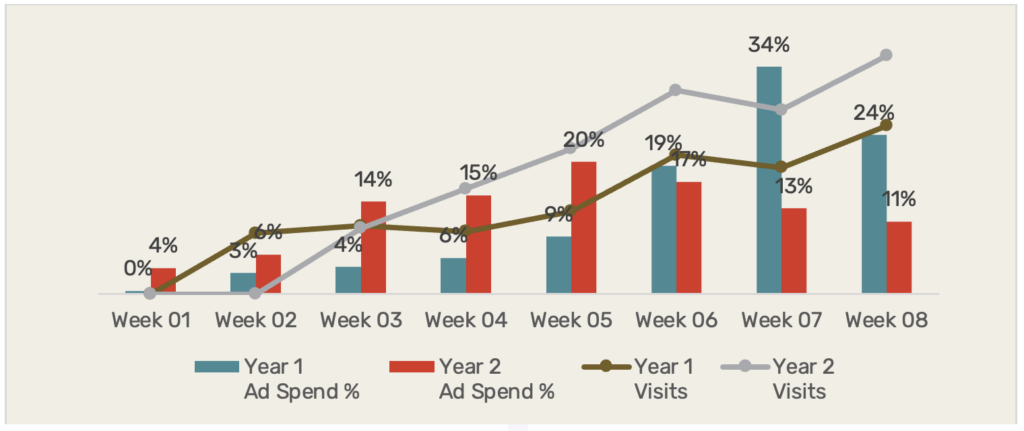
This chart displays the number of visits and corresponding ad spend percentages over an 8-week period for a 2-year period. The data highlights a significant increase in visits from Year 1 to Year 2, particularly in Weeks 5 through 8. Notably, ad spend percentages also varied between the two years, with higher ad investments in earlier weeks of Year 2 correlating with increased visit numbers. This suggests a strategic shift in ad spending contributed to the improved visitor metrics.
Family Attraction Visitation Synergies
Watauga’s study revealed that families who currently visit water parks also tend to visit other family-friendly attractions including amusement parks, family entertainment centers, and aquariums. These venues share a similar trait in that they all cater to the needs and interests of families, providing a safe, enjoyable environment where children and adults can have fun together.

78%
Have visited an aquarium

75%

57%
Have visited an family entertainment center
The commonality among these attractions lies in their ability to provide entertainment for all ages, fostering family bonding, creating lasting memories, and offering a welcome escape from daily routines and responsibilities.
To effectively capture the attention of these families and draw them to your water park, innovative digital marketing strategies can be employed to ensure your message resonates and reaches the right audience.
Conclusion: Maximizing Visitation with Family-Centric Marketing
By recognizing the pivotal role children play in family decisions to visit water parks, attractions can strategically tailor their family marketing efforts to engage both kids and their parents. Leveraging advanced targeting methods and employing family-centric promotional tactics, water parks can effectively reach and resonate with their ideal audience. This approach not only drives visitation but also fosters lasting family memories, ensuring a loyal customer base and sustained success. As water parks continue to evolve, staying attuned to family dynamics and digital trends will be key to maximizing their appeal and drawing in enthusiastic guests’ season after season.
For more detailed insights and strategies, be sure to check out Watauga’s 2024 Attraction Visitor Report and an interactive dashboard of our attraction research from over 3,500 survey respondents.

